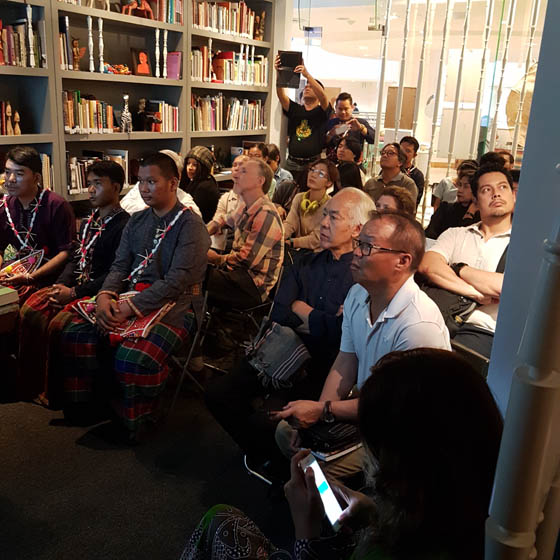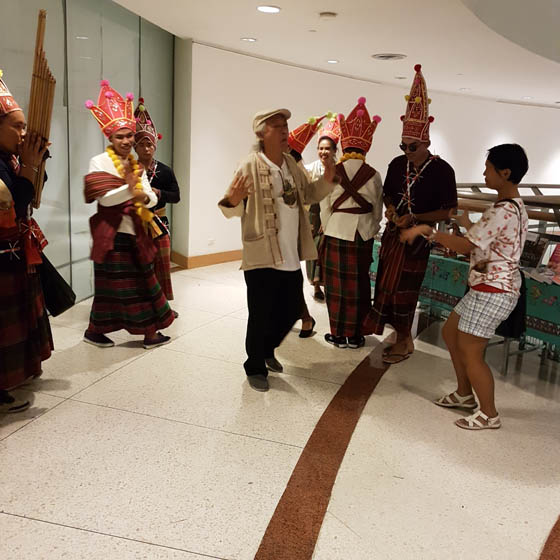Executive summary by Allan Beesey [1]
On 13 May 2017 the series “The Rice of Southeast Asia” was launched with a Public Lecture on the Origins of Tai Ancient Culture by Tongthan Natjumnong, editor of Siam Rat newspaper, historian, poet, and political commentator.
His talk cantered on rice cultivation at the root of mainland Southeast Asia societies before Buddhist-Brahmin influence and explored the ancient history of Tai and other cultures from Guangxi to Borneo. In his presentation, Tongthan Natjumnong discussed how studies of the Iban culture in Borneo, from excavations 2,000 years ago, reveal significant similarities with ancient Tai-Lao culture prior to Chinese and Indic influences. The emphasis of the talk was on the five elements that characterize Tai societies – the Tai-Kadai linguistic group from central China to southern Thailand; and indigenous societies of South East Asia further south. The term Tai (Dai) refers to Thais in Thailand and those from the same linguistic/cultural group outside of Thailand. There are a total of 62 different linguistic groups with a similar culture, mostly found in Laos, China, north Vietnam, northern Myanmar, and Assam in India.
 The five elements are rice, spirits, god (thaan), naga and souls. The staple food, rice, developed from using wild rice grains was cultivated several thousand years ago. Early rice was glutinous rice, with preparation and cooking utensils used 7,000 years ago, as shown in slides showing implements used in that period, very similar to that used today in domestic processing and cooking. Glutinous rice is commonly eaten in north and northeastern Thailand, however, nationwide long grain plain rice is the most common, as elsewhere.
The five elements are rice, spirits, god (thaan), naga and souls. The staple food, rice, developed from using wild rice grains was cultivated several thousand years ago. Early rice was glutinous rice, with preparation and cooking utensils used 7,000 years ago, as shown in slides showing implements used in that period, very similar to that used today in domestic processing and cooking. Glutinous rice is commonly eaten in north and northeastern Thailand, however, nationwide long grain plain rice is the most common, as elsewhere.
Rice cultivation contributed to Tai-Lao customs and the development of the 12 month system, where rituals and customs follow the seasons and the monthly agricultural activities. Rice was the centre of the culture and today the spirit of the rice is still propitiated in Thai-Lao communities as Mae Phosop, mother Phosop, a female spirit; however, in some parts of the Tai world we were told that the rice spirit is male. Spirits are everywhere, and are propitiated in nature and in places inhabited by humans. The types of sprits will vary, with spirits outside protecting nature and inside the home protecting inhabitants. The spirits (sometimes referring to, or translated as ‘ghosts’), make-up the ‘system of phii’ which is under the control of thaan, god. The meaning of ‘god’, is more like the original ancestor, even though thaan is central to myths and stories that explain the origin and evolution of Tai people. The naga (nak in Thai) is the river spirit, or the serpent that runs through Asian traditions as a symbol of life and fertility. Centuries ago the word used was nguak which today has transformed to refer to the destructive force of the water spirits, such as floods, drownings etc. as opposed to the life enhancing naga or nak. Souls refer to the life forces in the body, and according to Thongthan there were 80 to 100 such sites or nuclei in the body, until the advent of Buddhism, and today it is believed that there are only 32 kwan. In a simple summing up Thongthan suggests that:
Thaan is the controller of the phii system [the world of nature], naga is the controller of the waters that take care of the journey of “phi khwan” [of dead persons] to muang Thaan [heaven] after death.
The discussion centres around ancient beliefs prior to the establishment of Brahman/Hindu and Buddhist beliefs, and the maintenance of such beliefs in the modern period. These religious beliefs and practices began in the first millennium, and then Buddhism established itself across upper Southeast Asia from around the 14th century. Tai cultural beliefs were sustained during the second millennia, but in recent centuries in a very attenuated form. It was explained that in many instances the form or system of belief still exists, and may be observed through ceremony and ritual, but the understanding is confused, the explanation is missing. In much of the religious world of the Tai the old beliefs fuse with Buddhist and Brahmin beliefs and the original meaning lost. There are Tai highland groups, however, who have maintained these beliefs and have not become Buddhists. Among these groups are most of the Tai Dam, or black Tai, from Laos and North Vietnam. Many of these groups have traditions and beliefs more intact, and thereby act as a source for understanding ancient belief systems.
Tongthan answered questions on the phii system and the kwan, explaining how the kwan or souls can leave the body due to trauma, physical or mental afflictions, but can be restored. Today, shamans and some monks are said to be able to restore the kwan, mainly through ritual. The tying of string around the wrist, conducted by monks is very common for maintaining the kwan in the body, even though it predates Buddhist beliefs. However, elders often conduct this protective practice, and shaman (mor kwan), who specialize in restoring and maintaining kwan, will use such practices in their ritual.
The questions then turned to broader issues in the Tai and Mon-Khmer world. It is generally accepted that the Mon-Khmer were the original populations in central Thailand and Cambodia, while the Tais were further north of Thailand, including northern Burma, Laos and Vietnam, and of course China, where the original Tais may have come from. Hence, the Tai-Lao language was once considered to be part of the Sino-Tibetan language group. Their neighbours, the Vietnamese, under the control of China for the first millennia, are now regarded as Mon-Khmer, even though their physical features and language vary from neighbouring Southeast Asian countries. Thongthan suggested the Vietnamese language is derived from part Mon-Khmer, part Chinese and part local Viet, which is consistent with others who suggest it is a creole language. Mon-Khmer belongs to the Austronesian language group, which scholars have long thought was the origin of Tai-Kadai or Tai-Lao. More recently most scholars have considered the language as an independent family, or, as Austro-Tai.
The event was ensiched by musical and cultural performance. At the beginning, a parade and Wai Na Ta Haeg /Rice blessing was performed by the band of Yuthapong Maatwiset. in collaboration with Jim Thomson Farm. At the end the band also playes Esan music and participants danced to the tone.
[1] Independent researcher



